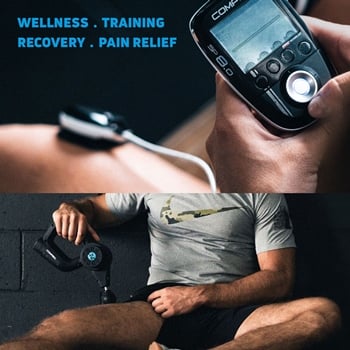-
Free Delivery - For orders over £60 & selected items
our blog post
Do compex muscle stimulators work?
Do compex muscle stimulators work?

How EMS (Electrical Muscle Stimulation) Works
Electrical Muscle Stimulation (EMS) is a technique that uses electrical impulses to simulate muscle contractions. This technology has been used in various fields, including physical therapy, sports training, rehabilitation, and fitness. EMS works by sending low-frequency electrical currents to muscles through electrodes placed on the skin. These impulses mimic the natural electrical signals that the brain sends to muscles to initiate movement. The underlying mechanism of EMS is both fascinating and complex, offering numerous benefits when used appropriately.
The Basics of EMS
At its core, EMS functions by applying electrical currents to the body through conductive pads or electrodes placed on the skin over specific muscle groups. These electrodes are typically connected to a device that generates the electrical impulses. Once the impulses are delivered, they activate the motor neurons responsible for controlling the muscles, causing them to contract. In natural muscle contraction, the brain sends electrical signals through the nervous system to motor neurons, which then prompt the muscles to contract. EMS bypasses the brain and directly stimulates the motor neurons, causing the muscles to contract without voluntary effort.
EMS systems typically generate impulses that mimic the natural frequency and rhythm of muscle contractions. The intensity, frequency, and duration of these impulses can be adjusted to achieve specific goals, such as improving strength, endurance, or muscle recovery.
Mechanism of Muscle Contraction
Muscle contraction occurs through a process called excitation-contraction coupling. In this process, electrical signals (action potentials) travel along the nerves and reach the neuromuscular junction, where the motor neurons connect with muscle fibers. At this junction, the electrical impulse triggers the release of calcium ions inside the muscle fibers, initiating the contraction process. EMS works by directly stimulating these motor neurons and triggering the release of neurotransmitters and ions, leading to muscle contraction.
When EMS is applied to a muscle, the electrical impulses stimulate the motor neurons, which activate the muscle fibers. This causes the muscle to contract and then relax. The force generated by these contractions depends on factors such as the intensity of the electrical impulses, the frequency at which they are delivered, and the specific muscle group being targeted.
Types of EMS Systems
There are various types of EMS devices, each designed for different purposes. The main types include:
1. Therapeutic EMS: This type of EMS is often used in physical therapy and rehabilitation settings. It helps reduce pain, prevent muscle atrophy (wasting), and improve muscle function after an injury or surgery. Therapeutic EMS is commonly used for patients with neurological conditions, such as stroke survivors, or for those recovering from surgery or musculoskeletal injuries.
2. Sport and Fitness EMS: This form of EMS is commonly used by athletes and fitness enthusiasts to enhance muscle strength, endurance, and recovery. These devices are designed to provide high-intensity contractions that mimic natural muscle exertion, potentially helping improve overall athletic performance and prevent muscle imbalances.
3. Cosmetic EMS: EMS can also be used for cosmetic purposes, such as toning and firming muscles, improving circulation, and reducing the appearance of cellulite. These systems typically involve lower-intensity currents to stimulate the skin and muscles, promoting muscle tone and skin elasticity.
Benefits of EMS
1. Muscle Strengthening: EMS helps improve muscle strength by inducing muscle contractions. For individuals unable to perform traditional resistance training, such as those with mobility impairments or injuries, EMS offers a non-invasive alternative to maintain or build muscle strength.
2. Rehabilitation and Injury Recovery: EMS is widely used in physical therapy to help accelerate the recovery of muscles after an injury. It can help reduce swelling, improve blood flow, and prevent muscle atrophy by stimulating muscle activity when the individual cannot engage in traditional exercises.
3. Pain Relief: EMS is effective in managing pain through a process known as "gate control theory." The electrical impulses can block pain signals from reaching the brain, reducing the sensation of pain. EMS is also believed to promote the release of endorphins, the body's natural painkillers, providing additional pain relief.
4. Muscle Endurance and Performance Enhancement: By training muscles with EMS, athletes can increase muscle endurance and overall performance. EMS stimulates muscles in a way that mimics high-intensity exercise, helping athletes improve stamina and speed up the recovery process between workouts.
5. Improved Circulation: EMS can improve blood circulation by stimulating muscle contractions, which in turn increases blood flow. Better circulation helps deliver oxygen and nutrients to the muscles, enhancing recovery and promoting overall muscle health.
6. Toning and Firming: EMS is often used in cosmetic treatments to tone and firm the muscles, especially in areas like the abdomen, thighs, and buttocks. By causing muscles to contract, EMS can lead to improved muscle definition and skin appearance.
Risks and Considerations
While EMS has numerous benefits, it is important to use the technology responsibly. Improper use or excessive intensity can lead to muscle strain or discomfort. Individuals with certain medical conditions, such as pacemakers, epilepsy, or pregnancy, should avoid using EMS unless cleared by a healthcare professional. It’s also crucial to follow proper guidelines for device settings and electrode placement to prevent injury or ineffective stimulation.
Conclusion
In summary, EMS is a powerful technology that harnesses electrical impulses to stimulate muscle contractions. It has a wide range of applications, from therapeutic uses in rehabilitation to enhancing athletic performance and even improving skin tone. By bypassing the brain’s natural pathways for muscle activation, EMS offers a unique approach to muscle conditioning, pain management, and recovery. When used correctly, EMS can be a valuable tool in both fitness and rehabilitation. However, as with any technology, it’s important to use EMS responsibly and under the guidance of professionals to maximize its benefits and avoid potential risks.
If you want to try Compex muscle stimulation, you might like to use one of our hire packages. We include a 30 minute video consultation with our Physio and if you decide to buy, we refund the full cost of the hire.
Visit our Compex page here





